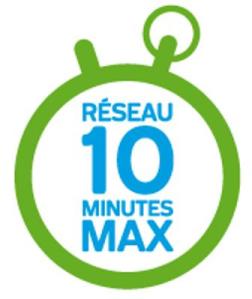Montreal to brand its 10-minute max service
There are already many routes in Montréal that have a service frequency of more than 1 bus every 10 minutes, however, the STM has decided to launch a new branding called “Réseau 10 minutes MAX”. This branding will appear on buses, bus stop signs and perhaps even next year’s network map.
This idea seems to be rapidly catching on all over the world. Jarrett Walker at Human Transit has been promoting this idea via his web site.
The following lines will have at least 6 buses per hour between 6h and 21h:
18 Beaubien
24 Sherbrooke
51 Édouard-Montpetit
67 Saint-Michel
69 Gouin
80 du Parc
105 Sherbrooke
121 Sauvé/Cote-Vertu
139 Pie-IX
141 Jean-Talon Est
165 Côte-des-Neiges
Additionally, the following lines will have at least 6 buses an hour in one direction the either in the AM (6h to 14h) or PM (14h to 21h) peak periods (these are pretty generous definitions):
32 Lacordaire
33 Langelier
44 Armand-Bombardier
45 Papineau
48 Perras
49 Maurice-Duplessis
55 Saint-Laurent
64 Grenet
90 Saint-Jacques
97 Mont-Royal
103 Monkland
106-506 Newman
132 Viau
161 Van Horne
171 Henri-Bourassa
187 René-Levesque
193 Jarry
197 Rosemont
211 Bord-du-Lac
470 Express Pierrefonds
Since I live in NDG I decided to see what this announcement actually means in practical terms to the 90 and 105 routes that stop at Vendome metro:
90 Saint-Jacques East Bound: (16 extra departures per day)
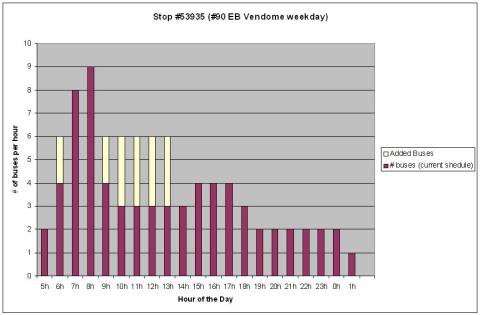
90 Saint-Jacques West Bound: (5 extra departures per day)
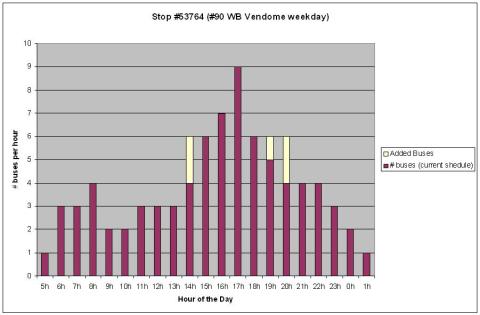
105 Sherbrooke arriving at Vendome: (6 extra arrivals per day)
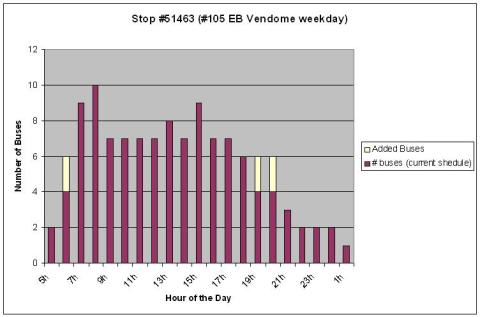
105 Sherbrooke Departing from Vendome: (9 extra departures per day)
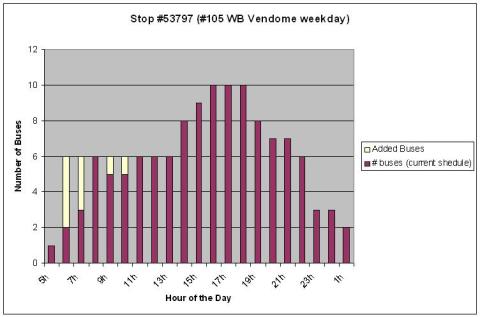
Notes:
- The red color is the existing service as of August 25th. However, the publicly available information just shows a “…” when there is more than 1 bus every 6 minutes. In this case, I just assumed it was every six minutes (that’s why none of the charts go higher than 10 buses). I could be wrong however for some of the most popular lines.
- The tan color represents the extra buses added to the service pattern as a result of the new branding.
- I assumed that if there were already 6 buses or more during that hour then the STM would not add any more. This is likely to be true since this parameter is constrained by the number of buses and drivers that the STM has available.
- I assumed that the STM would only add enough buses to hit the 6 per hour rate – they could add more.
These charts show that for both types of branding (the all day and the peak period) there is still quite an increase in service. Well done STM!
Here’s their new map
Bixi in London Data analysis
A clever developer has come up with a very good analysis tool of the usage patterns of the London Bixi bikes that started about two weeks ago
(each second is one hour starting at 0:00 = midnight)
This real-time data was captured each hour by James Chesire from the data generated by Oliver O’Brien at University College London. He used the real-time data from Transport for London real-time data to develop an real time view of bike/dock availability in London
The color mapping more easily allows you to see how the bikes move from the outskirts to the city centre and back again over the course of a day. The bike docks at the mainline stations are particularly affected by this effect. Only a small percentage of travelers on a train need to use Bixi to completely saturate the system which seems to be one of the major problems of the system in its first few weeks of operation.
Yonah Freemark has a much better analysis than me on his blog
Blog entry of the Oliver O’Brien that developed the app
Real time View
Is there anything like this in Montreal other than the Google overlay apps that require you to click on each dock to see the status?
Bixi in 2 Washingtons!
The Gazette is reporting today (May 21, 2010) that the city and Bixi together have announced that bixi will be deployed in Washington DC and the University of Washington in Washington state.
Starting this fall, 1100 bikes and 114 stations will be deployed in Washington DC and Arlington VA.
30 bikes will be available at Washington State University – presumably for the start of the September semester. No news about how may stations or bike docks. Based on the ratio of Washington DC, there should be only 3! No news about how many bike docks for each however.
The Washington DC announcement is very interesting because the city already has a contract with a different bike sharing company – SmartBike by Clear Channel. The limitations of this system is that it is much more expensive to deploy since the road needs to be dug up to install the docking stations. The current system, after at least one year, has 125 bike docks in 10 stations. Perhaps the reason why the city decided to move to a different system could be explained here?
See the summary page for Bixi tracking
Toronto to get Bixi?
The Public works and Infrastructure committee of the city council of Toronto will vote on April 20 to accept the deal that the city staff had negotiated with the Bixi.
If the vote is passed, 1000 new Bixi’s will be rolling on the streets of Toronto in the summer of 2011.
In reading this document, some interesting details come out:
- For a project of 1000 bikes and 80 bike stations, an initial outlay of 4.8 M$ is necessary. Montreal spent 15 M$ for 3000 bikes in phase I plus another 7 M$ for 2000 extra bikes in Phase II
- The yearly operating costs are anticipated to be 1.2M$. I think Montreal’s 15 M$ and 7M$ include the operating costs.
- Approximately 1% of bikes are expected to be vandalized beyond repair per year. Montreal’s first year number was 125 bikes (phase I, in Montreal had 3000 bikes = 4%)
Numbers for Montreal’s first year of operation:
- 11000 subscribers * 78 $ = 858,000$
- 113000 single day users * 5$ = 565,000$
- Usage costs = ?? (no info about this)
- 60% of the single day users were tourists!
Toronto reports:
As far as I know, this kind of information is NOT available to the public in Montreal. Generally you have to go the the council meeting to look at a binder that has the information. There is no web site that archives this material. You need to file an access to information request to get it.
Update May 15, 2010 – Bixi approved for a 2011 launch!
Bixi Tracking
Last February, Bixi announced that it had been chosen for the public bike project in Minneapolis and Melbourne. Bixi will now be on 3 continents!
Short comparison of the current Bixi systems:
| City | Bikes | Stations | Bike docks |
Ratio of bikes / docks |
| Montreal (phase I + II) | 5000 | 400 | 7800 | assume 65% |
| Boston | 2500 | 290 | 3750 | 67% |
| London | 6000 | 400 | 10000 | 60% |
| Melbourne | 610 | 52 | 1000 | 61% |
| Minneapolis | 1000 | 75 | 1300 | 77% |
| Toronto (2011) | 1000 | 80 | 1500 | 66% |
| Washington DC (fall 2010) | 1100 | 114 | 1700 | assume 65% |
| Univ of Washington(fall 2010) | 30 | 3 | 45 | assume 65% |
If we use the average ratio of 65% there are 7800 bike docks in Montréal. (Italics are calculated numbers – not provided in press releases)
According to this document (7MB download), New York city is talking about a project with 10000 bikes in the first phase (Manhattan below 60th street & parts of Brooklyn). If this first phase is successful, it could be expanded to 49000 bikes in all boroughs except Staten Island.
The report seems to favour the Bixi technology for several reasons:
- Since excavation of streets to install the bike station is not needed, the capital costs are lower.
- No need for hydro hook up since the stations are solar powered (the smart bike stations in Washington DC have a electricity meter on a pole next to each bike station)
- Flexibility to move stations around to allow for special events
- Stations are expandable to add or remove bike docks as needed
Although a lot of attention is paid to the visible aspects of the system, equally important to the success of the system is the back end information systems to make sure:
- Customers don’t get overcharged
- Bikes don’t get lost or stolen
- Sufficient bikes are available where and when people want them
- Sufficient bikes docks are available where and when people want them
- Technical support via multiple technologies (email / phone)
Kudos to:
- Dallaire Design (for the design of the bikes & overall system)
- Cycles Devinci (for the manufacture of the bikes)
- 8D Technologies (for the payment station and the back-end software)
- Robotics Design (for the docking station)
The choice of using the existing Stationnement de Montréal infrastructure (which is provided by 8D technologies) has allowed Montréal to really demonstrate its savoir-faire (and to win an award!)
If only Bixi could expand to NDG! Then I might sign up for it. Will it be cheaper in 2010? The answer is unfortunately No. But you can get a 10$ discount on the yearly subscription if you sign up before May 15th.
UPDATE: April 14/2010: Bixi is recommended by the City of Toronto staff.
UPDATE: May 15, 2010: Bixi approved by the city of Toronto’s council for a 2011 launch.
UPDATE: May 21, 2010: Bixi going to two Washingtons
STM Launches new Airport Shuttle Service
The STM has announced a new bus service between the airport and the Voyageur bus terminal. This new line will have
- Intermediate stops at Metro Lionel-Groulx, Gare Centrale, Metro Berri-UQAM
- Travel time of approx 30 minutes one way
- $7 cash fare (you are actually buying a 1 day tourist pass) each way
- Full 24/7 service with frequency every 20 minutes in rush hour and even every hour overnight – same as night bus service frequency
- UPDATE 2010-08-20: The current service pattern has 77 trips per day each way approximately every 10 minutes during the day (still every hour during the night)
Comparison with the proposed airport rail link
At an average speed of 11 km/h for the service (without traffic) it will be interesting to see how this will demonstrate the need for the rail shuttle project. Rail shuttles typically will be significantly more expensive (at least 15$) but will be much faster and reliable. Since the airport is only 16km from the city centre, you could expect a rail shuttle to only take about 10 minutes assuming no intermediate stops – at least 3x faster.
Read more »
Bixi Chosen by London & Boston
Montreal’s Bixi bike system has been selected as the technology to use for the bike sharing programs what will be implemented in Boston and London.
London will have 6000 bikes distributed over 9 districts
Boston will use Montreal’s call centre. Luckily, for the success of the system, helmets are only mandatory for children under 16 in Massachusetts.
Some of the announcements:
The Gazette
Transport for London
Boston Announcement
There are competitors to our bixi however :
B-cycle has a pilot system in Denver
Here’s a very favorable review in the Boston Globe
Bike share seems to be sweeping over the continent!
Trams to return to Vancouver
Trams will make a special appearance during the Olympic games in 2010 from January 21st to March 21st.

Brussels Flexity Tram
A special demonstration line will run from the new Canada line station on Cambie Street to Granville Island. It will be 1.8km of single track line with a passing loop ½ way (the red part in the image below). STIB, the public transport operator in Brussels, will provide two of their new Bombardier Flexity trams. The best part – it will be free! If successful, the system could be expanded to go to Stanley Park via the skytrain stations of Main Street and Waterfront (the blue part).

Street car route
The participants of the demonstration project are:
- City of Vancouver
- CMHC (Canada Mortgage and Housing Corporation)
- STIB (Société des Transports Intercommunaux de Bruxelles)
- Bombardier
As the pictures on Bombardier’s web site show, this is definitely a temporary installation. The catenary poles are just normal telephone poles! It does appear that even though there is an existing rail line, the entire track is being renewed.
With a passenger capacity of 178 (seated + 4 pers/m2 standing) and 6 doors per side, this vehicle will show to Vancouverites what can be done with modern transportation systems.
More information:
http://olympichostcity.vancouver.ca/gettingaround/publictransit/olympicline.htm
More News about Trams vs. Buses
Writing my previous post caused wordpress to amusingly automatically create a link to a pro-tram blog in Edinburgh (a very nice city that I have visited – I went to the Haymarket train depot of First Scotrail).
This link caused me to discover that similar discussions have been held in Edinburgh and West London precisely about this topic. They write about it far more elegantly than I ever could! The result – Trams are what are needed.
To be fair here is the other side of the discussion: Pro-Trolley bus
I have to say that the picture in the pro-trolley bus is more like a rubber-tired tram. These have been tried in a few French towns Clermont-Ferrand (home of Michlenin), Nancy (disaster of a project), and Caen with not very much success. In fact these trams-on-wheels are no cheaper than a real tram.
Nobody is saying that trams should be everywhere in the city. They are desperately needed on the routes such as Cote-des-neiges, Parc, Pie IX, Notre Dame, Cote-Vertu/Henri Bourassa where buses cannot provide a quality service even though there is (at peak times) a bus every five minutes.
The problem in many cities is the “metro or bust” phenomenon. Metro’s are only needed on routes where really high capacity is needed. Anything else is served by buses. Pushing metro extensions and nothing else generally ensures that the project doesn’t happen because the projected ridership is simply not there to make the project viable. In the mean time, car use and urban sprawl continue to rise.
What is needed is a medium capacity service (at medium cost). That is where the tram comes in!
 Comments (2)
Comments (2)